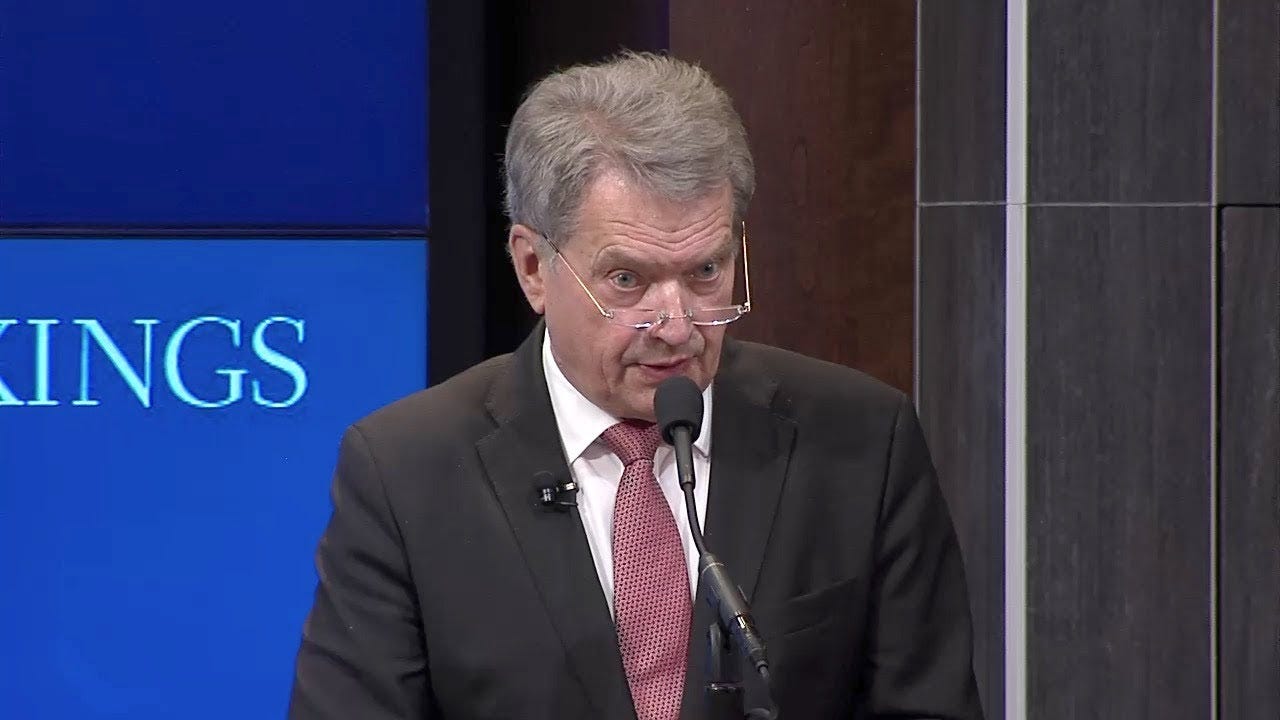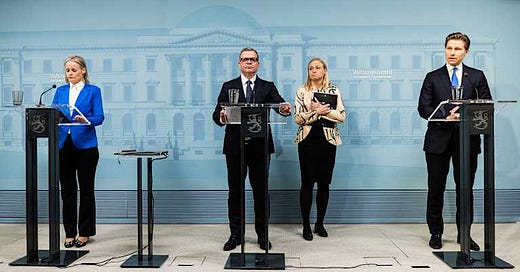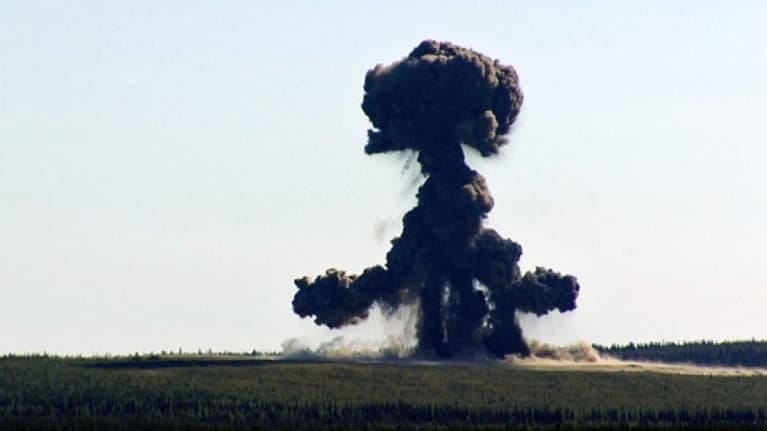Finland Increasing Defense Spending, Bringing Back Landmines
Finland responds to Russia's growing capabilities by joining Poland and the Baltic States in leaving the Ottawa convention and by further increasing its defense spending to at least 3% by 2029.

At the beginning of April, the Finnish government announced two initiatives to improve its own defense. From a Finnish Government Press Release:
Finland will begin the preparations for withdrawal from the Convention on the Prohibition of the Use, Stockpiling, Production and Transfer of Anti-Personnel Mines and on their Destruction (the Ottawa Convention). The President of the Republic of Finland and the Ministerial Committee on Foreign and Security Policy decided on the matter in their joint meeting today….
Finland has been a party to the Ottawa Convention since 2012. Since then, the security environment has deteriorated fundamentally and for the long term. Russia is not a party to the Ottawa Convention and it has used anti-personnel mines in its war of aggression against Ukraine. As a NATO Ally, Finland is also defending the Alliance’s border with Russia.
The Government’s decision is based on an assessment completed last week by the Defence Forces and on preparatory work by officials at the Ministry of Defence and the Ministry for Foreign Affairs. In the view of the defence administration, anti-personnel mines are well suited for Finland’s national defence. Anti-personnel mines make it possible to slow the advance of the attacker and minimise the defender’s casualties. Anti-personnel mines are technically simple and are therefore well suited for training and use in a conscription system. They can also be produced quickly and in large quantities in Finland.
Finland was the last European Union member state to join the treaty but is not the first to announce that it is leaving. Estonia, Lithuania, Latvia, and Poland have also recently announced that they would formally leave the treaty.
According to Human Rights Watch, Finland had 1,029,763 antipersonnel mines when it joined the treaty. All of these were destroyed by the end of 2015.
Decision was controversial at the time

Finland’s decision to join the treaty was widely criticized through the past few years. Jussi Niinstö, Finland’s Minister of Defence from 2015-2019, was critical of the decision since the beginning. In November of 2011, just before Finland’s Parliament (the Eduskunta) voted to join the treaty, he wrote on his blog (translation via Microsoft Bing):
The Ottawa Convention is unequivocally bad for Finland's national defense and it is also economically irrational. This is being done at the same time as the Defence Forces are under the greatest pressure to cut back in peacetime.
Anti-personnel mines are cheap, easy and effective. They make it more difficult for the enemy to dismantle anti-tank mines, in particular, and protect areas for which there are not enough soldiers. Finland has long borders, but few defenders. Studies have shown that the enemy infantry's advance speed increases up to three times if the defense does not have mines at its disposal.
In Finnish terrain, nothing can replace anti-personnel mines. There is no replacement weapon system for it. By their very existence, mines raise the enemy's threshold for attack. In peacetime, anti-personnel mines are stored in the Defence Forces' warehouses and do not cause problems for anyone….
The only responsible solution is to vote against the government's proposal.
However, Finland’s President at the time, Tarja Halonen, believed that the reputational damage done to Finland by remaining outside the treaty outweighed the defense considerations. From a 2004 article:
According to President Tarja Halonen, Finland cannot postpone giving up anti-personnel mines for much longer. Halonen insists that Finland must definitely give up anti-personnel mines in the next few years and make a decision on replacement systems in this year's Defence Policy Report.
Halonen, who met with political journalists on Friday, said that anti-personnel mines have eroded Finland's credibility abroad.
Halonen said that she has come across the issue many times abroad and that she always receives a flood of letters from NGOs from time to time.
In the President's opinion, Finland is acting with double standards when it supports the implementation of the Mine Ban Convention in EU resolutions, but does not do it itself. According to Halonen, it is clear that Finland cannot at least renew its aging mines.
The wisdom of this decision was further questioned after Russia’s invasion of Crimea in 2014.
In 2018, Niinistö, then Defence Minister, championed a remotely triggered “bounding mine” to replace those banned by the Ottawa convention.
Calls for withdrawal grew in 2024
In November of 2024, Finland’s Chief of Defence, General Janne Jaakkola, told MTV (a Finnish broadcaster) “that Finland should be open to discussing anti-personnel landmines:”
Jaakkola argued that the security environment has changed significantly since Finland in 2012 joined the Ottawa Convention prohibiting the use of landmines.
He stated that Russia's large-scale ground force deployments in Ukraine highlight how Finland should adapt to counter military threats.
In talking to MTV, Jaakkola did not take a position on whether Finland should withdraw from the Ottawa Convention, as such a decision is political. He did, however, suggest more public discourse not only on anti-personnel landmines but also on new defence technologies.
A Citizen’s initiative calling for Finland to renounce its commitment to the Ottawa Convention began collecting signatures on December 6, 2024- Finland’s Independence Day. The required 50,000 signatures were collected within four days.
Since then, Finland’s Ministry of Defence submitted a report which stated
anti-personnel mines are well suited for Finland’s national defence, making it possible to slow the advance of attackers and minimise the defender's casualties.
The report also pointed to the mines' technical simplicity and ease of use in Finland's conscription system, as well as how easily they can be produced.
Additionally, popular politicians such as former president Sauli Niinistö (no relation to Jussi Niinstö) and current President Alexander Stubb gave statements supporting the reintroduction of landmines.
Withdrawal takes about six months
Finland’s Ministry for Foreign Affairs is currently preparing a government proposal on the matter. The withdrawal itself takes effect six months after the UN Secretary General receives notification from Finland.
One oddity of the Ottawa Convention is that if a nation is at war when it submits notice to the UN of its withdrawal, the withdrawal only takes effect when the war is over.
Major non-signatory nations include the USA, Russia, and China.
Defense Budget Increase
According to the same press release:
Petteri Orpo's Government has decided that Finland will increase the level of its defence appropriations to at least three per cent of GDP by 2029. The Ministerial Committee on Economic Policy agreed on the matter on Tuesday.
The Government also decided that the Defence Forces will launch materiel projects for the Army in a frontloaded manner.
“The solution will help us further strengthen Finland’s defence. It will allow the Defence Forces to take a longer-term approach so that it can immediately begin its work to modernise the Army and strengthen resources on a threat-informed basis,” said Prime Minister Orpo.
Finland’s position on how much the NATO defence spending target should be increased will be agreed on separately before the NATO Summit in The Hague.
Yes, that’s at least three percent of GDP, with the actual amount to be agreed upon separately before the June 2025 NATO summit.
In the area of procurement, it is now the turn of the Finnish Army, following the acquisition of four corvettes for the Finnish Navy (currently under construction) and the decision to acquire 64 F-35s for the Finnish Air Force. As for what the Finnish Army is looking to buy, we can look to Finland’s 2024 Government Defence Report:
Materiel will be procured for artillery, infantry, ground-based air defence and unmanned aviation to improve the Army’s ability to effect. During the period of the report, the Army will decide on the replacement of the towed light artillery units that are at the end of their life cycle. The firepower of the artillery will be improved bearing in mind the requirements the operating environment places on long-range fires, on the provision of close support for troops in battle and on the ability to locate the enemy’s firing units.
The firepower and mobility of the infantry will be modernised by replacing the ageing armoured infantry combat vehicles and by raising the number of combat vehicles as required by threat environment and collective defence commitments. A process to modernise the Army’s firearms will be started during the period of the report. Its extent will be decided at a later stage. Mid-life upgrades of the main battle tank fleet will sustain the Army’s operational counterattack capability. The range and quantity of anti-tank weapons will be increased. The mobility and protection of the Army will be improved by procuring more armoured personnel carriers and by ensuring the mobility of forces in the north.
When it comes to munitions, Finland is also adding capacity. At the end of January, Finnish Defence Minister Antti Häkkänen announced that a new TNT factory will be built in Finland. According to the press release, this will be the second plant producing TNT explosives in the EU (the first is in Poland).
If only all European Nations took their defense as seriously as Finland.
Thoughts and Comments
These two actions- bringing back anti-personnel mines and increasing defense spending- are just the latest initiatives in Finland’s response to a more assertive and capable Russia.
The decision to join the Ottawa Convention dates back to a time when the relationship between NATO and Russia was at its best and the largest threat to European security seemed to come from foreign-born terrorists. Along with joining the treaty, the Finnish Government began Reform 20151, a program to decrease the size and reduce the operating cost of the Finnish Defence Forces. At one point, the government seriously considered ending mandatory conscription. (All Finnish men must serve in the Defence Forces. This service includes 6-12 months training as a conscript and then mandatory service in the reserve until age 50. Women can volunteer, and men who do not wish to serve in the armed forces can instead opt for a 12-month civilian service position).
This all changed when Russia invaded Ukraine and annexed Crimea in 2014. Although it was too late to abandon Reform 2015, the Finnish government immediately saw the need to prioritize defense readiness. The defense budget grew, acquisition programs began again, and improving readiness became a high priority. Following Russia’s escalation of the war in 2022, the Finns recognized the importance of a consistent supply of arms and took additional steps which included joining NATO.
All of this was in direct response to the increased threat to Finland from Russia. Finns have said many times that they do not outsource their defense; a lesson learned during the Winter War of 1939-1940.
A Wall Street Journal Editorial from April 3, 2025 attributes these changes to a ‘more aggressive Russia and a less reliable United States':
The Finns take their preservation more seriously than the European defense-spending laggards the Trump Administration complains about. That is from long experience of sharing an 800-mile border with Russia.
Adding Helsinki to the NATO alliance was a force multiplier, particularly large Finnish military reserves and expertise in winter warfare. But the Finns aren’t betting on peace. They’re reading the room of a more aggressive Russia and a less reliable United States, and reorganizing accordingly.
I don’t think that last sentence is quite right. The Finns have been ‘reading the room of a more aggressive Russia" since February of 2014. When the first Trump administration encouraged European allies to spend more on their own defense, Finnish leadership agreed. In a September 2018 speech at the Brookings Institute, Finland’s then President Sauli Niinistö said:
For seventy years already, NATO has to a large degree meant the United States. The Americans have shouldered the lion’s share of the burden for Europe’s security. It has been highly valuable for Europe. And we fully understand why the US expects Europe to do more for its own security.
This is precisely what we aim to do now. I have been calling for a stronger European defence for over a decade already. I am delighted to see that there is finally movement in this field.

In 2024, former President Niinistö called again for Europe to do more in a report to the European Commission:
Writing just a week before key US presidential elections, Niinistö said the EU (European Union) needed to send a signal that it was willing to pay its way on defence, adding that the bloc should spend around 20% of its budget, currently worth around €1 trillion over seven years, on security and crisis preparedness….
"Member States should strengthen their cooperation on European defence, jointly investing more to close long-standing gaps in our military and defence industrial readiness,” he added.
"Despite an increase in member states' defence budgets last year, fewer than one in five investments in defence programmes are made jointly, and 82% of defence funding and procurement is allocated nationally.
Although Niinistö was talking about the EU budget specifically- as that was the report he was tasked to write- his remarks apply to member states, as he encourages them to work together to fill the gaps in European security.
I worked closely with the Finnish Ministry of Defence and Finnish Defence Forces during President Trump’s first term. When many were calling out a perceived lack of U.S. support to NATO back then, one diplomat told me Europe’s ‘little secret.’ That is, everyone focuses on the U.S., because very few European nations believe that their neighbors have the capability and will to come to their defense in a war with Russia. There is some truth to that, if you look at the poll numbers. It is also why many view the rise of China in the Pacific as a European threat- because it could keep the U.S. from defending Europe. But that is an article for another day. I also plan to cover Finland’s conscription program and take a closer look at the steps Finland took since 2014, showing that it is indeed serious about defense.
Until next time.
All the best,
PGR
Reform 2015 was done thoughtfully in an attempt to reduce operating costs so that Finland would retain functioning defense forces despite planned smaller budgets. This meant reducing acquisitions, reducing the number of personnel, and re-aligning commands to gain efficiency. Although there were gains in efficiency, there was definitely some buyer’s remorse about the reform when I arrived in Finland in 2017 because of deferred procurements and a smaller force size.





"Si vis pacem, para bellum"
What is the penalty if an Ottawa Convention member nation violates the agreement? And why does it take so long for a member to formally resign once they have made the decision to leave?
Go back to old school.